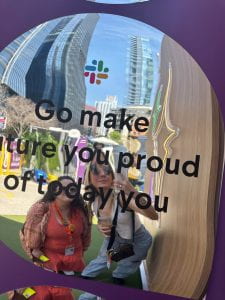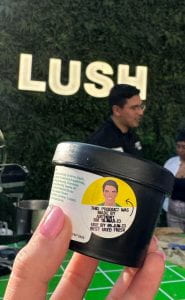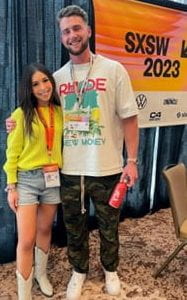By Lo Moss and Sarah Jane Eckelkamp
Priming, Rhyming, Timing, and Other Marketing BS (*Behavioral Science)
Nancy Harhut, Co-Founder & Chief Creative Officer HBT Marketing
The first talk we attended during the week was with filled with valuable insights about consumer behavior and it’s impact on marketing, specifically in a digital space. This session focused on BS…Behavioral Science… and how the study of how people make decisions often comes down to default because our perceptions create our reality. Interestingly enough, sometimes, as marketers, we can shape perceptions using techniques like priming.
 Priming, has to do with how the brain associates concepts, and it influences behavior. Priming can drive preference and spending. When it comes to using this technique, priming in terms of time has been found to be more valuable and personal. Focusing on time and experience seems to make consumers more willing to spend and less likely to experience the “pain of spending.” Choosing words and phrases that prime behavior takes consideration, research, and insights into how consumers make their decisions. She stated it’s been found that priming in terms of time is more valuable and personal and thus by focusing on these things in initial copy, the typical consumer will me more willing to spend money, and again, less willing to experience that cognitive dissonance and pain of spending…especially if it’s a product or service that doesn’t provide immediate gratification. Prime in introduction copy is also important in terms of pricing because the words and phrases we use shape expectations and perceptions.
Priming, has to do with how the brain associates concepts, and it influences behavior. Priming can drive preference and spending. When it comes to using this technique, priming in terms of time has been found to be more valuable and personal. Focusing on time and experience seems to make consumers more willing to spend and less likely to experience the “pain of spending.” Choosing words and phrases that prime behavior takes consideration, research, and insights into how consumers make their decisions. She stated it’s been found that priming in terms of time is more valuable and personal and thus by focusing on these things in initial copy, the typical consumer will me more willing to spend money, and again, less willing to experience that cognitive dissonance and pain of spending…especially if it’s a product or service that doesn’t provide immediate gratification. Prime in introduction copy is also important in terms of pricing because the words and phrases we use shape expectations and perceptions.
Another key tool, with priming, is rhyming, because rhyming, according to Nancy’s research, makes thing seems more truthful, accurate, and credible because it’s easier for the human brain to process and thus “feels right.” For example, we all know a memorable and credible subject and headline can draw people in. Jingles are just rhymes set to music more often than not — think of Folger and Haribo.
We found several concepts within this talk that related and were extremely relevant to Dr. Alice Kendrick’s classes at the Temerlin Advertising Institute. She even has students to rhyming / song writing as an assignment to show how such acts can effect memory of concepts.
We learned that priming and rhyming effect cognitive fluency and that things like alliterations and similes can make this more credible, more memorable, and overall easier to understand. Word play can also help with creating a mental image, helping consumers envisions themselves with the product, especially when it’s not one that provides instant gratification.
Timing was the last major point of this sessions. Priming and rhyming won’t work if the timing is wrong. There are times when consumers are more open to marketing messaging and things like cusps can help prompt people, and salience can make a prompt more prominent. Temporal landmarks are also very important as they are periods that are transitional times or fresh starts. However, Nancy discussed that our future selves can often be strangers and therefore temporal discounting is also to be accounted for. If pay off in the future, for example: education, we have to overcome the need for instant gratification. Getting consumers to see themselves in a future scenario.
 This was one of our favorite sessions of the entire weekend and a great way to kick off the week.
This was one of our favorite sessions of the entire weekend and a great way to kick off the week.
Key Takeaways:
- People are more likely to do what you want them to if you use the right priming
- Words with similar sound are more easily found because the brain like rhyming
- New days and fresh starts are key. Though futures are hard to see. It’s all about the timing.
Ephemeral Trend Culture is Transforming Business
Lorry Destainville, Head of Global Partnerships – TikTok
Jamie Gilpin, Chief Marketing Officer- Sprout Social
Change is constant, and in the age of TikTok, trends are moving faster than we’ve ever seen. Now, it’s hard to look at the past for success measurement because of how fast things are changing, but these fast micro trends are a result of larger macro ones: emerging technology, increased consumer expectations, shift of power and control to the consumer. Social media, TikTok, is at the center of this, and marketers are challenged to keep up. We learned to understand that the goal is not the jump on trends, but rather to affluenly align your brand with them. With the speed of trends on TikTok, “anyone is invited” says Lorry, and true moments are able to be shown in a way that captures viewers attention…with the help of the heir sound on feature which hinders multitasking.
Despite the fast pace, there are sustainable ways to leverage trends. Simply leaving comments and knowing when to pass where two suggestions for how to leverage trends without investing big dollars. The power of comments is underutilized and a sustainable way to utilize quick moving trends.
Several grad students even had the opportunity to speak with Sprout CMO, Jamie Gilpin (pictured below). They asked her about her referring to TikTok videos as art and the future of search on social platforms.
Teaching Truth In The Era of Book Bans + Banned Books Library
Sumi Cho, Director- African American Policy Forum
Cierra Kaler-Jones, Executive Director- Rethinking Schools
Nelva Williamson, High School Teacher- Young Women’s College Preparatory Academy
Carleen Pickard, Advocacy & Activism Manager- Lush Cosmetics
This session was sponsored by Lush Cosmetics and was led by Carleen Pickard, the Advocacy and Activism Manager from Lush Cosmetics. The panel featured three speakers: Sumi Cho, Cierra Kaler-Jones, and Nelva Williamson.
The speakers emphasized the importance of freedom of choice in a democracy, and how book bans are antithetical to the way a democracy is  supposed to function. The most impactful quote that stuck with us from this session was “not all books are for all kids”. This hits home to a core truth- it is imperative for kids to have access to a wide variety of reading material, and it is up to parents to discuss their own boundaries that they want to implement for their family. As a former teacher, I knew I wanted to go to this session and planned part of our day around it. Sarah Jane was not as familiar with this controversial topic as I was, with my background as a middle school teacher prior to starting the grad program at SMU. Sarah Jane learned a lot and was baffled by some of the arguments that parents and politicians put forward regarding books. We also visited the Banned Books Library, which is an art installation at the Austin Hilton designed by artist Karyn Holyk. The installation was truly beautiful and featured books wrapped in white paper, with some titles written on them and others remaining nameless. It highlighted the emphasis that we place on books and the importance of allowing access to materials. Sarah Jane and I both grew up as readers, as we were fortunate enough to have parents that encouraged us to explore the world around us and expand our horizons. We agreed that parents have a right to limit what their own child has access to, but they do not have the right to limit what other children have access to.
supposed to function. The most impactful quote that stuck with us from this session was “not all books are for all kids”. This hits home to a core truth- it is imperative for kids to have access to a wide variety of reading material, and it is up to parents to discuss their own boundaries that they want to implement for their family. As a former teacher, I knew I wanted to go to this session and planned part of our day around it. Sarah Jane was not as familiar with this controversial topic as I was, with my background as a middle school teacher prior to starting the grad program at SMU. Sarah Jane learned a lot and was baffled by some of the arguments that parents and politicians put forward regarding books. We also visited the Banned Books Library, which is an art installation at the Austin Hilton designed by artist Karyn Holyk. The installation was truly beautiful and featured books wrapped in white paper, with some titles written on them and others remaining nameless. It highlighted the emphasis that we place on books and the importance of allowing access to materials. Sarah Jane and I both grew up as readers, as we were fortunate enough to have parents that encouraged us to explore the world around us and expand our horizons. We agreed that parents have a right to limit what their own child has access to, but they do not have the right to limit what other children have access to.
This session reminded us of the subject material taught in Dr. La Ferle’s class, Advertising As A Cultural Force. The ethics that come into play when dealing with book bans tie directly to the material we learn in the course. Additionally, the idea of regulation and governmental guidelines are a difficult topic to handle in general, much more so when it comes to education as a whole. For the most part, advertising is a self-regulatory field and requires involvement and “buy-in” from all of the players in the industry. We think that this could be a potential solution to the issues we see in the education field. Politicians and policymakers need to take direction from teachers, not the other way around. If the education system could regulate themselves while partnering with the communities around them, it would increase awareness as to the real issues that teachers face and facilitate real solutions.
Lush Future Shock; Handmade is Our Middle Name
Louise French, Strategy Director- The Future Laboratory
Anthony, Compounder- Lush Cosmetics
The Lush House was one of our favorite stops during SXSW. Each day, they had multiple sessions about a range of topics, including: Web3, ethical digital  engagement, climate change, digital divestment, and civic participation. Our favorite session was “Future Shock: Handmade is our Middle Name”, where Anthony and Louise from Lush spoke on the value of handmade products in the face of an autonomous future. Anthony, one of the compounders at Lush, did a live demonstration of the process behind making a best-seller: “Angels on Bare Skin”, a face and body cleanser. Louise answered questions from the crowd regarding the future of Lush and her vision for the co-existence of handmade, artisanal products and the tech world. Everyone at the event got to take home a jar of the Angles on Bare Skin cleanser, and we even got to label and package the items ourselves. Sarah Jane and Lo were in the front row (of course) and answered a few questions from the hosts. The event was filmed, so who knows- you might see us on some Lush Cosmetics social channels very soon!
engagement, climate change, digital divestment, and civic participation. Our favorite session was “Future Shock: Handmade is our Middle Name”, where Anthony and Louise from Lush spoke on the value of handmade products in the face of an autonomous future. Anthony, one of the compounders at Lush, did a live demonstration of the process behind making a best-seller: “Angels on Bare Skin”, a face and body cleanser. Louise answered questions from the crowd regarding the future of Lush and her vision for the co-existence of handmade, artisanal products and the tech world. Everyone at the event got to take home a jar of the Angles on Bare Skin cleanser, and we even got to label and package the items ourselves. Sarah Jane and Lo were in the front row (of course) and answered a few questions from the hosts. The event was filmed, so who knows- you might see us on some Lush Cosmetics social channels very soon!

Porsche Collaborations Unseen offered several opportunities for speaking sessions and events this weekend, and we took advantage of several of them: Porsche x Finder, Porsche UX to DX, Porsche x Daniel Arsham. The Porsche UX to DX session was intriguing because they discussed how they use user feedback and consumer involvement to build their product. Not just social listening, but personal user listening that enables them to focus on driver experience, not user.
The Porsche x Daniel Arsham event was something Sarah Jane was extremely motivated to attend because Daniel Arsham has been one of her favorite artists for some time now. His work is inspired by decay, fossilization, and post-apocalyptic visions that have been modernized. His work with Porsche is extensive, but this event debuted his car, the Nebula, which was done in collaboration with Porsche and is Daniel’s take on how the car could have continued through the decades and evolved into a Y2K aesthetic era.
Other Activations and Exhibitions We Loved…
- Patagonia
- Dolby House
- Audible Sound Studio
- Plant Music Lounge by PlantWave
- Slack
- Have A Good Trip
- Wonder House
- Why a Great User Experience is Key to Advertising
- LEGO Play Lounge
- Future Collectibles: A Collective Effort to Bringing Luxury Goods to Web3





